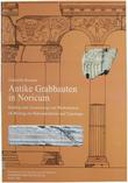Explore

Die meisten der aus der Provinz Noricum stammenden römerzeitlichen Werkstücke aus Stein waren ursprünglich Teile von Grabbauten. Im vorliegenden Manuskript wird der Versuch unternommen, die architektonische Form dieser Grabbauten zu rekonstruieren, eine Typologie zu erarbeiten und daraus historische sowie kunsthistorische Schussfolgerungen zu ziehen.Aus der Form der Werkstücke, den technischen Bearbeitungsspuren sowie der Struktur und dem Inhalt der plastischen Darstellungen und Reliefs können Informationen für die Verwendung dieser Bauteile im architektonischen Zusammenhang gewonnen werden. Anhand eines Vergleichs mit den ganz erhaltenen norischen Grabbauten aus Sempeter deren Rekonstruktion einer ausführlichen kritischen Beurteilung unterzogen wird - und mit Grabbauten Italiens sowie anderer römischer Provinzen ist es in vielen Fallen möglich, einen Rekonstruktionsvorschlag zu erstellen. Zusätzliche Anhaltspunkte werden aus einer Zusammenstellung aller Grabungsbefunde gewonnen, bei denen bearbeitetes Steinmaterial vorkommt.Auf diesem Weg wird erstmalig ein Überblick über die in der Provinz Noricum vorhandenen Grabbautypen gewonnen. Die erstellte Typologie erlaubt auch eine Einordnung der meisten nicht rekonstruierbaren Einzelteile.Insgesamt werden 227 Werkstücke oder Werkstückgruppen im Katalogteil I den Grabbautypen 'Aedicula', 'Baldachin', 'Altar', Weiler', 'Gemauerter Grabbau', 'Tumulus' oder 'Umfassung' zugewiesen, teilweise rekonstruiert und Großteils in zeichnerischen und fotografischen Abbildungen präsentiert. Die 414 Teile des Katalogteils II sind nicht eindeutig einem bestimmten Grabbautyp zuweisbar, doch kann in vielen Fallen ihre Position am Grabbau bestimmt werden. Katalogteil. III umfasst 44 Grabungsbefunde.Die Auswertung des im Katalogteil vorgelegten Materials geht auf die Einordnung der einzelnen Grabbautypen im architektur- und kunstgeschichtlichen Zusammenhang ein. Die chronologische Entwicklung und die spezifische norische Ausprägung der einzelnen Typen wird besprochen. Anhand der Inschriften und der Reliefdarstellungen wird der etwaige Zusammenhang von Grabbautypus und gesellschaftlicher Stellung der Grabinhaber untersucht. Mit Hilfe von Verbreitungskarten wird schließlich die unterschiedliche Häufigkeit bestimmter Typen in den einzelnen Regionen der Provinz herausgearbeitet und hinterfragt.Im tabellarischen Anhang I sind aussagekräftige Maße und Proportionen bestimmter Architekturglieder aufgelistet. Anhang II fährt diejenigen Grabbauten oder Grabbauteile an, deren Typus bestimmt werden kann und deren Inhaber zumindest ansatzweise bekannt sind.Ein umfangreicher Abbildungsapparat verfolgt den Zweck, die vorgeschlagenen Rekonstruktionen und Einordnungen nachvollziehbar zu machen, indem auch die Stoß- und Ladeflächen samt ihrer technischen Details dokumentiert sind. Die rekonstruierten Grabbauten werden anschaulich dargestellt, jedoch ohne die Grenzen zwischen Originalbestand und Rekonstruktion zu verwischen.
This book is included in DOAB.
Why read this book? Have your say.
You must be logged in to comment.
Rights Information
Are you the author or publisher of this work? If so, you can claim it as yours by registering as an Unglue.it rights holder.Downloads
- 163 - pdf (CC BY-NC-ND) at OAPEN Library.
- 129 - pdf (CC BY-NC-ND) at OAPEN Library.
- 254 - pdf (CC BY-NC-ND) at OAPEN Library.
Keywords
- Ädikula
- funerary monuments
- Graz
- History
- Humanities
- Marmor
- Noricum
- Noricum, funerary monuments
- relief
- Spolie
- thema EDItEUR::N History and Archaeology::NH History
- V. Chr.
Links
DOI: 10.26530/oapen_437190Editions

